« January 2005 | Main | March 2005 »
February 28, 2005
Graffiti as Conversation

Spatial Annotation
"I've been photographing layers of conversation in graffiti, and tagging the pictures with conversation. Prior art for spatial annotation?
Spatial Annotation Projects: a (GREAT) list of spatial annotation projects and platforms. Thanks to physcomp, interactionfield and aware for inspiration." From elastic space [via]
Posted by jo at 02:14 PM | Comments (0)
Towards an Emotional GPS:

Writing Your Own City
"...Psychogeography and cognitive mapping offer two suggestions for recording wireless experiences, using a term we've coined, emotional GPS. Whereas traditional GIS (Geographic Information Systems) and GPS (Global Positioning Systems) tend towards an empirical representation of the world, emotional GPS is biased towards the personal, temporary, and imaginary. In most cases, the prevailing impact of wireless on the definition of a place is not so much on its static form as the potential experiences that this place can afford. The wireless environment provides an alternative use, an augmented interface, or new associative mnemonics. Providing an annotative mapping framework, use of emotional GPS fosters a networked mobility within these environments that undermines the authoritarian bent of traditional GIS and GPS mapping techniques." From Towards an Emotional GPS: Writing Your Own City by Scott Paterson, with Marina Zurkow and Julian Bleecker, Intelligent Agent, Vol. 3 No. 2.
Posted by jo at 10:52 AM | Comments (0)
RESONANCES AND EVERYDAY LIFE:
Ubiquitous Computing and the City
Abstract: Ubiquitous computing seeks to embed computers into our everyday lives in such ways as to render them invisible and allow them to be taken for granted, and social and cultural theories of everyday life have always been interested in rendering the invisible visible and exposing the mundane. Despite these related concerns, social and cultural studies remain in the background of discussions of ubiquitous technology design. This essay seeks to introduce researchers in both fields to each other, and begin to explore the ways in which collaboration might proceed. By exploring mobile and ubiquitous technologies currently being used to augment our experiences of the city, this paper investigates notions of sociality, spatialisation and temporalisation as central to our experiences of everyday life, and therefore of interest to the design of ubiquitous computing." Resonances and Everyday Life: Ubiquitous Computing and the City (DRAFT) by Anne Galloway. [via]
Posted by jo at 10:36 AM | Comments (0)
Ad Hoc Information Spaces
Temporary Networks
"Abstract: We describe the concept of ad hoc information spaces as a way of distributing information in an environment depending on user mobility and relative location. Ad hoc information spaces are realized using a decentralized approach to ubiquitous computing, which is based on functionally self-contained devices and ad hoc networking. Users are able to contruct and manipulate the properties of these information spaces by means of moving and manipulating a variety of devices. In order to explore the possibilities of using ad hoc information spaces to support group collaboration, three prototypes were developed: the Hummingbirds, the Generalized Hummingbirds and the NewsPilot. These are described along with some of the empirical findings that support their design." Ad Hoc Information Spaces - Johan Redström, Lars Erik Holmquist, Per Dahlberg and Peter Ljungstrand. [via]
Posted by jo at 10:29 AM | Comments (0)
Geo-Heritage
![]()
Flexible Storytelling
"...Storytelling is one of the oldest art forms of human beings; initiated in the oral tradition, its form has evolved with changes in society and available media with which to work. The oral storyteller often altered the tale as it was told, choosing words based on response from the listeners to build the collective moment. Of particular relevance here is the Australian Aboriginal storytelling tradition in which territory is not perceived of as a piece of land enclosed within borders but rather as "an interlocking network of 'lines' or 'ways through'" (Chatwin 1987). Sung into existence by the ancestors, these stories actually function as maps of their terrain that can be augmented by travelers to account. Interactive in the beginning with the advent of the written medium, storytelling, however, evolved into a non-interactive narrative style..." From Geo-Heritage: A Living Archive of Spatial Culture by Scot T Refsland, Marc Tuters & Jim Cooley. Also read Bits and Bytes of Locative Geo-Heritage by tV.
Posted by jo at 09:55 AM | Comments (0)
Vivienne

Virtual Girlfriend
"The International Herald Tribune writes about Vivienne, the new 3G girlfriend created by Artificial Life, a software house in Hong Kong. It'a a virtual application with a computerized synthetic voice who likes to receive flowers and chocolates, translates six languages and can converse on 35,000 topics. The service is already available in Malaysia and Singapore, and will arrive in Europe later this spring.
At the moment V-Girl is basically considered a game (it won the global Best Mobile Game Award by Ericsson). Apart from this use for lonely hearts, the application developed by Artificial Life might become very interesting, especially for companies that want to enhance the management of the relationship with their customers." [blogged on making money out of mobile]
Posted by jo at 09:27 AM | Comments (0)
Adaptable Girl Performance Collective

global_interface workshop series
New Media comes to University of California at Riverside in a series of workshops on new media practice.
They purpose that "this critical collaboration across the disciplines of the academy mirrors the global interface itself. Mark Poster outlines how digital technologies like the Internet can traverse the limits of traditional communication models, such as print and broadcast, as follows:
1) Enabling many-to-many communications;
2) Enabling simultaneous reception, alteration, redistribution of cultural objects;
3) Dislocating communicative action from the posts of the nation;
4) Providing instantaneous global contact;
5) Inserting the modern/late modern subject into a networked information machine apparatus.
Humanity is no longer constituted by clearly bounded subjects, but instead begins to function more like a network, in which individuals act "as a point in a circuit." The global interface serves as the site where this transformation occurs."
Singing G4s Song: Digital-on-Human Performance Practice in Late Capitalism: Monday, February 28, 2005, 12:00 p.m. - 2:00 p.m.
Location: Arts Building 166 (Performance Lab)UC Riverside.
Description: The merging of virtual and real audio spaces through the
proliferation of digital tools has dramatically impacted praxis for a number
of artistic genres. This performance/lecture brings together musicians and
dancers in an improvisational installation that explores the extension of
live performance through digital processing. Featuring music, dance and
video, the work will also deploy a number of digital performers, including
programmed audio improvisers (in max), digital cameras, even an iPod. The
performers will discuss the installation and the broader impact that digital
technologies have had on their own artistic practice.
Adaptable Girl Performers:
Ramie Becker is a Ph.D student in Dance History and Theory.
Renee Coulombe is an Assistant Professor of Music Theory and Composition.
Maria de los Angeles "Cuca" Esteves is first year MFA student in Creative
writing and Writing for the Performing Arts.
Isabel Valverde, a choreographer/performer and researcher, recently
completed her Ph.D. in Dance History and Theory at UC Riverside, and is
presently pursuing a postdoctoral program at UC Irvine.
Elizabeth Venable is a Ph.D. student in the Dance Department.
Sponsor: Mellon Workshop
Contact: global_interface@hotmail.com
Join the Global Interface blog:
http://globalinterface.blogspot.com
Posted by michelle at 04:18 AM | Comments (0)
February 25, 2005
SOUND ART MUSEUM
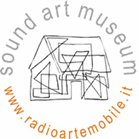
Radio Arte Mobile
Sound Art Museum, Rome, February 26th, 2005; broadcasting live on http://www.radioartemobile.it (Boston and N. Y. 12:30 p.m.; Bogota 1.30 p.m.; London 5.30 p.m.)
18:30: Larissa Harris at MIT Center for Advanced Visual Studies, Boston; François Bucher Bogota. Artists participating in the show Inaudita Roma, Ron Kuivila for Art in General New York.
19:00: Daniel Soutif at Centro per l'Arte Contemporanea Luigi Pecci Prato; Claire Staebler at Radio Day De Appel Amsterdam; Ian Aman, Joachim Granit e; Carsten Holler at Fargfabriken Stockholm; Richard Crow e Lucia Farinati at IOR London
Sound Art Museum is both an exhibition space dedicated to sound and vision, a collection of sound-projects by artists, and a mobile archive. The sound invades the scene of art and the artists' practice, triggering original, fascinating and, sometimes unforeseen, combinations. A new collective and international sensitiveness is seeking to gather and convey the reasons of these harmonies and these dissonances.
Radio Arte Mobile, located in via Conte Verde 15 in Rome, will open its doors to the public on occasion of the inaugural exhibition INAUDITA of the Sound Art Museum.
Installations by Acconci Studio, Markus Huemer, Donatella Landi, Stephen Vitiello and Achim Wollscheid, will be presented together with artworks of Mario Airo, Massimo Bartolini, Bruna Esposito, Vettor Pisani, Michelangelo Pistoletto, Annie Ratti, Gert Robijns.
It will be displayed a selection of sound art from the Archive of the Sound Art Museum, which has already filed more than 350 international and national audio works.
In collaboration with Nomads & Residents a series of appointments in institutional locations all over the world is scheduled, where the archived materials will be available for public use.
The curators of the Sound Art Museum are Lorenzo Benedetti freelance curator, Riccardo Giagni composer and musicologist, and Cesare Pietroiusti visual artist.
The Sound Art Museum archive is a work in progress, all artists who have worked or are working with sound are always invited to send the an artwork on audio CD DVD or on a vinyl record.
Posted by jo at 06:10 PM | Comments (0)
the FluxusPerformanceWorkbook
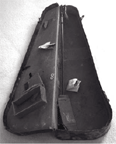
Performances in Musical Form
"The first examples of what were to become Fluxus event scores date back to John Cage's famous class at The New School, where artists such as George Brecht, Al Hansen, Allan Kaprow, and Alison Knowles began to create art works and performances in musical form. One of these forms was the event. Events tend to be scored in brief verbal notations. These notes are known as event scores. In a general sense, they are proposal pieces, propositions or instructions.
The first collections of Fluxus event scores were the working sheets for Fluxconcerts. They were generally used only by the artist-peformers who were presenting the work. With the birth of Fluxus publishing, however, colections of event scores soon came to take three forms..." From the introduction to the FluxusPerformanceWork book edited by Ken Friedman, Owen Smith and Lauren Sawchyn.
Posted by jo at 06:00 PM | Comments (0)
A r/c tivism in Physical and Virtual Spaces
![]()
Free Communication
"Reclaiming the streets, producing an emancipatory public sphere - how does that work in a society that many call the information society, in which it seems that the spectacle has taken the place of political debate, in which urban space is progressively trimmed to neoliberal/economic imperatives. What has thrust itself onto the stage of a globalized public sphere since the protests against the World Trade Organization meeting in Seattle[1], politically ambiguous[2] yet unmistakable in the potpourri of forms of expressions, represents a practice of dealing with these kinds of questions.
What happens behind the scenes of the colorful video images of protest, which, in fact, largely still adhere to thoroughly traditional patterns in terms of form, mode of production and discourse? What is going on in the virtual and physical workshop spaces of the globally networked movements?[3] How does the virtual space of the Internet relate to geographically definable, "real" locations? Can they still be clearly distinguished, how do they merge? How is the understanding of space and communication changing within the relatively small, relatively privileged[4] group of those active in alternative media with the rapid appropriation of information technology?" From A r/c tivism in Physical and Virtual Spaces by Marion Hamm.
Posted by jo at 05:25 PM | Comments (0)
Version>05>Invincible Desire

CALL FOR PROPOSALS AND WORK
Version is an international festival about art, media, technology and politics. Our fourth annual convergence, Version>05> Invincible Desire, will examine the activities of local configurations and external networks that use visual art, innovative social practices, artist initiatives, creative uses of new technologies, organizing strategies and public interventions in order to engage in cultural reclamation. Through a diverse program featuring an experimental art expo, artistic disturbances, networked urban events, screenings, interactive applications, performances, workshops, art rendez-vous, parties, and action, Version>05 will investigate the urgency for interventions in everyday life, the organization of our shared interests, and the distribution of our ideas.
We will convene in Chicago for a ten day open laboratory to explore a diversity of tactics and strategies to activate our communities and amplify our ideas. The city of Chicago will be used as a map to examine microactions. Blueprints will be unveiled to strengthen emerging alliances and counter institutions. Alternative spaces will be open for staging actions. Public spaces and corporate places will be terrains of intervention.
We seek to explore methods to enjoin the public in a dialogue about pressing issues and ideas of our age. We want to share your actions as well as projects and activities that can help us to transform personal and shared environments. It is our hope that the issue will offer ways to engage in meme warfare, practice social engagement and produce instruments of transformation during these dark ages.
Posted by jo at 01:41 PM | Comments (0)
Taxi_onomy

The Ultimate Vehicle for Psychogeography
Taxi_onomy, by Celine Condorelli and Beatrice Gibson, is an urban mapping project and mobile cartographic research endeavour that seeks to re-appropriate the black taxi as the ultimate vehicle for psychogeography, based on its capacity for metro processing and spatial understanding. Tax_ionomy will utilise the black taxi for the purposes of enabling artists and the general public to create and utilise emotional, cognitive and networked maps of the city.
Taxi_onomy - a live art project to take place in a taxi; the practice of classification from the purview of the taxi. Mumbai, a Taxonomy of the City is now available to view on line.
Posted by jo at 01:15 PM | Comments (0)
Multimedia Performance after Dumb Type
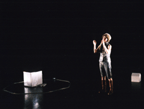
New Movement Emerges
In 90's, Dumb Type established multimedia performance in Japan. Teiji Furuhashi and Dumb Type in early 90's were legend of Japanese Multi Media Performance and Media Art for their works, for example, "S/N"(Dumb Type) and "Lovers"(by Teiji Furuhashi).
In this season, I have a presentiment of stages after Dumb Type. There was a competition called Yokohama Solo X Duo Compe'tion + R at the end of January. This competition has a relation with a French famous competition called "Recontres Choreographique Internationales de Seine-Saint-Dennis." [posted by Yukihiko YOSHIDA]
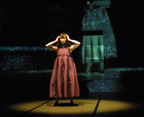
In this competiton, there are many multimedia Performance and performance with robotics. Thee winner of this competition, Mariko Okamoto, used interesting robotics in her piece. A young Japanese girl sits down on a small refrigerator and moves little by little. Small robotics move beside her on the stage. One of the dancers, such as Mariko Kon'no, whom I introduced in this blog before, danced sharply with video art by Haruo Higuma, who is a well known artist in this
field.
A very successful work is "Alicetopia" by Satoko Yahagi in early February. Yahagi got an idea from a picture book "Alicetopia." Yahagi's dance and choreography are under the influence of Surrealism. The aestheics of Surrealism arranged the visual effect of this work. I have a presentiment of a new movement after Dumb Type after seeing this work.--Yukihiko YOSHIDA
Photo Credits:
French Embassy Prize for Young Choreographers Mariko Okamoto, "sputonik*gilu" Photo:Yoi'chi Tsukada
Satoko Yahagi,"Alicetopia", Photo: Kei Yasuda, Dance Cafe
Posted by jo at 09:57 AM | Comments (0)
February 24, 2005
Liveform Telekinetics [LF:TK]
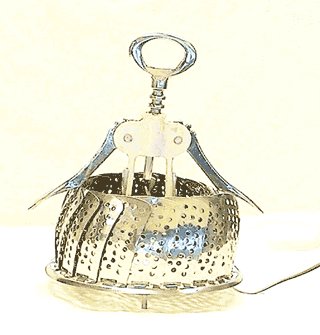
Experiments in Connected Social Spaces
"...Sharing a meal, a walk in the park, weddings, sports, or cafés...are the kind of social activities and rituals we associate with human relationships...What if you could go out for dinner and dancing with friends, even though you're a thousand kilometers away?...(W)ireless Internet "hotspots"...provid(e) the possibility of multi-situated presence, but (are) also placed within a fixed physical location, a social environment rich with familiar objects, rituals and codes of behaviour.
LF:TK takes a playful approach to the ways we might inhabit such a hybrid environment. Furniture, decorations, cutlery, bric-a-brac and cultural debris are reconstructed as networked interfaces that populate surfaces within everyday social spaces. Each object provides a simple function, yet when combined with others helps build a complex arrangement of movement and gesture. Imagine a shared creation, a social ritual, a dance through objects, a table that is played." [Recipe for Corkscrew Man]
Posted by jo at 05:34 PM | Comments (0)
Ku:iyashikei-net

Tear 2 Tear [T2T]
Ku:iyashikei-net by Urico Fujii and Ann Poochareon is a networked crying sculpture that allows people to communicate through the interface of tears, a physical output of human emotional expression that has been overlooked, and never made exchangeable with current communication devices. Two sides, installed at different locations, communicate over the Internet. On Side A, Tear Well allows a sad person to express his/her feeling by pumping a traditional water pump, the water representing her/his tears. The tears are sent over to Side B over the Internet, where teardrop sculptures called KU act as networked surrogates.
As soon as Side B receives the crying signal, KUs start to cry. When a viewer on Side B wipes KUs’ tears, KUs stop crying. At the same time comforting response is sent to the sad person to cheer them up. Read PDF [blogged by regine on near near future]
Posted by jo at 11:36 AM | Comments (0)
The New Performer: Data as Performer and Performance
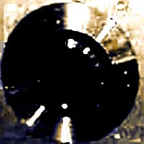
In Pursuit of the Virtual Performer
"The nature of all performance includes the elements of time-based experience and space as "stage". I use the term "stage" as a simple reference point to describe the space in which a performer performs and not as reference to the theatre. The nature of performance in the computer age includes these elements of time and stage as space. A simple definition of performance is : that which is feigned or pretended. It is action. It is speech. It is anything performative. The nature of the performer includes any entity who/which feigns, pretends, acts, and speaks. So, it is natural to include non-human entities, such as robots, cyborgs, and databases in this discussion of performance. Baudrillard might describe performing and the performer as more real than real, so real that they are virtual. "Of course we have a multitude of objective, real proofs, but what does one do with historical reality in a system which itself has become virtual? "(1)
New media's complex nature has influenced the nature of performance to become something many don't consider performance. Anything involving action, interaction, time, and space is performance. Therefore, performing is both real and virtual, becoming more real than real through the very nature of simulation. Performance on and of the net includes everything from virtual actors (interactors) interacting with real actors, Moos, Mud's, Mucks, Games, Chat groups, telepresence, Database as performance. The performer is data. The performer is virtual. The history of virtual performance begins with interaction between the real and hyperreal in time-based experience in a space referred to as the stage." From The New Performer: Data as Performer and Performance by Sheila A. Malone.
Posted by jo at 08:11 AM | Comments (0)
February 23, 2005
Negotiating the In-Between:
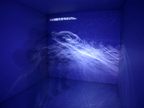
Liquid Boundaries
Abstract: As an artist working in the field of virtual reality, I explore dynamically emergent environments with immersive, interactive display systems, which enable me to produce performative realities in which the boundaries between the Self and the (alleged) Other become liquid. This paper addresses the representational issues and performative aspects of virtuality and, through discussion of two of my works, examines the ambiguities inherent in contemporary technological expressions of a more or less disembodied Self as it inhabits (tele-)immersive virtual environments. Read Negotiating the In-Between:Space, Body and the Condition of the Virtual by Petra Gemeinböck, Crossings: Electronic Journal of Art and Technology, Issue 4.1
Posted by jo at 03:59 PM | Comments (0)
Interaction in Art and Technology

static>>dynamic-passive>>dynamic-interactive
Abstract: The interest of artists and art theorists in audience participation with artworks has been particularly active since the 1960s. Interactive artworks that could transform viewers into participants were envisaged and created using the media available at that time. Today the opportunities for including audience participation have been increased significantly by the widespread availability of digital technology. The degree of collaboration between technologists and artists affects the necessary interaction between artist and computer. This paper discusses the role of technology in interactive art and the complex ways in which the artist can interact with computers and digital media in order to specify artworks. Categories of interactive art systems defined earlier as static, dynamic-passive, dynamic-interactive and dynamic-interactive (varying) are brought up-to-date and illustrated by examples of work from the Creativity and Cognition Research Studios. Read Interaction in Art and Technology by Linda Candy and Ernest Edmonds, Crossings: Electronic Journal of Art and Technology, Issue 2.1
Posted by jo at 03:50 PM | Comments (0)
Seine hohle Form

Collaborating on Interactive Performance Works
Abstract: Composers and choreographers face unique and largely unexplored problems as they collaborate on interactive performance works. Not the least of these problems is settling on schemes for mapping the various parameters of human movement to those possible in the world of sound. The authors' collaborative piece, Seine hohle Form, is used as a case study in the development of effective mapping strategies, focusing on dance gesture to real-time music synthesis. Perceptual correlation of these mapping strategies is stressed, albeit through varying levels of abstraction. Read Seine hohle Form: Artistic Collaboration in an Interactive Dance and Music Performance Environment by Joseph Butch Rovan, Robert Wechsler and Frieder Weiß, Crossings: Electronic Journal of Art and Technology, Issue 1.2
Posted by jo at 03:38 PM | Comments (0)
Stelarc
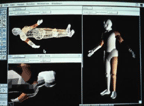
The Body as Host For a Remote Agent
From The Body by Stelarc, Switch Journal #19, 2005:
Movatar: When I started experimenting with involuntary body movements we quickly realized as well as the Body being locally controlled it might be possible with a touch screen interface to control the Body remotely. In fact we did a performance at Telepolis. We constructed a touch screen interface that allowed people in Paris, Helsinki and Amsterdam to access my body in Luxembourg and by touching the muscles on the computer model you could effectively program the choreography of the remote body in Luxembourg. You could do this either by pressing the touch screen or by pasting together from a wide array of gesture icons and then press Play and the physical body would respond in Luxembourg.
I could see the face of the person who was moving me, they could see my evolving body movements or their choreography. The body then became a kind of host for a remote agent. The idea that you could access part of my body from another place and physically actuate it. And in this performance those people in the three cities were able to access and move the Body over a period of three days.
Ping Body: We also used the ping internet protocol in a performance where the Body was moving through internet data. During the performance I would ping 40 global sites. The reverberating signals were measured in miliseconds mapped to the body muscles in a very crude way, but what was effectively happening was that the body was becoming a barometer of internet activity. The moved according to the internet activity from that global site.
Read The Body by Stelarc, Switch Journal #19, 2005
Posted by jo at 02:52 PM | Comments (0)
February 22, 2005
Brainscore
![photo06[1].gif](http://www.turbulence.org/blog/images/photo06[1].gif)
Avatars As Virtual Filters
Brainscore, by Darij Kreuh and Davide Grassi, features two performers in front of a screen where computer-generated events are projected. A console allows performers to act in a virtual reality environment through their avatars.
Three electrodes attached to the performer's heads transmit the brain's electric signals to an electroencefalograph, which analyses and transfers them to a computer, which in turn processes them. An eye-movement tracking system enables the performers to control visual entities in Virtual Reality by their eye movements. Viewers watch the performance wearing polarized glasses to perceive the events in 3D as appearing between the two performers. The flow of the information moves from physical space into virtual (performers > avatars) and than back (avatars > audience). Avatars act thus as a "virtual filter" between performers and audience. [blogged by Regine at near near future]
Posted by jo at 03:27 PM | Comments (0)
Welcome To The Scene
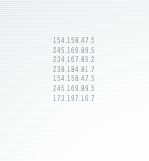
A Serial Drama from the Point of View of Webcam
""The scene" in this case refers to the social culture that goes along with the "pirate" infrastructure (the so called "darknet") that is behind the release of Hollywood movies onto the Internet. We see that scene through fictional character Brian Sandro, NYU college student and member of the notorious CPX release group.
The drama unfolds entirely from the point of view of a webcam focused on Brian at his computer and a recording of his desktop as he IM's, browses the web, rips DVDs, listens to mp3s, etc. Of course, looking at someone's desktop is normally boring but in this scripted desktop world its the vehicle for the character interactions, so we see Brian as he organizes rips with his release group mates, makes shady side deals with a street vendor in Asia, worries about financial aid and flirts with his girlfriend." [blogged by akb on Demand Media]
"Refreshingly, unlike most other 'net only tech related video dramas this one has a story line and character development. Brian descends into addiction and lies with increasing frequency to cover himself. The viewer experiences the dissonance of the unpleasant real world, with its crappy food service job, boring classes, and financial problems, when it intrudes into the fantasy world of "the scene" where Brian is an untouchable worldwide hero.
In addition to the unorthodox storytelling technique, "Welcome To The Scene" innovates on several other fronts that show a savy sure to be copied in the future by other independent producers of independent online video.
# Its delivered as a serial. That is, 4 episodes in have so far been released with the next scheduled for March 4th. Getting your audience to come back for more (stickiness) is crucial to building an audience for future projects.
# The show is licensed under a Creative Commons license, allowing it to be freely distributed by anyone.
# The show has agreements with other entities, for instance it has sponsors that get a plug as each episode begins and features the music of independent musicians.
# On the tech front, the show is available in high quality and makes excellent use of delivery technologies. Luckily, like anime, the content compresses very well, so 800x600 video can be delivered at 300kbps. The show is available via major p2p protocols (bittorrent, Ed2k, Gnutella, Fasttrack ). This leverages both bandwidth savings and the communities around the respective p2p networks.
One important thing to note, "Welcome To The Scene" is not produced by a college kid in their dorm room. Its produced by Jun Entertainment. They seem like a small shop with a corporate client list whose principals have a standard corporate background who have hired a college kid that knows about file sharing. For some the smell of venture capital and market seeding interferes with the enjoyment of the product, for some it does not. Regardless, there is some enjoyable content for Joe netizen and valuable lessons for hopeful Internet video distributors."
Posted by jo at 03:02 PM | Comments (0)
CallCutter
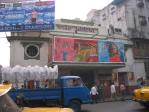
Participants Unknowingly Become Actors
"Your mobile phone could be your ticket to a site-specific play that takes you through the labyrinth of north Kolkata. To take part, call 98318-80501 from February 26, the opening day for this two-month-long project, CallCutta.
Once you are chosen, all you have to do is listen to instructions on the phone and take a trip that begins from Star Theatre and is most likely to end on the terrace of a house. It touches several historical landmarks via many bylanes, back alleys and bustlings streets. If you are lucky, at the other end of the line, it could be Priyanka Nandi, a student of English (Hons), whose endearing voice will leave you wondering whether it’s the beauty of the city or the urge to simply listen to her that has goaded to you take a nearly hour-long walk. Max Mueller Bhavan has brought this novel concept to the city. Actor-filmmaker Anjan Dutt will capture the trips on camera." A Unique Theatre Comes Calling on Your Mobile Phone by Pratik Ghosh, HindustanTimes.com, Kolkata, February 21, 2005 [via textually.org]
"This unique concept has been developed by a three-member German/Swiss theatre group Rimini Protokol comprising Helgard Haug, Stephan Kaegi and Daniel Wetzel.
Helgard, who seems to know that part of the city more than a diehard Kolkatan, says: “A participant unknowingly becomes an actor when he trusts a stranger on the phone and strikes up a conversation.”
The concept focuses on a one-on-one format, which is a deviation from the convention that hinges on a collective performance on stage.
“The idea is to operate on a personal level,” says Kaegi, who admits to being inspired by the call-centre style of operation. “If someone in Europe or the US relies on an Indian on the phone for buying goods and services, it shows man has an innate tendency to trust,” he says.
The eight persons who will be answering calls from an office in Salt Lake attended a workshop which gave them a detailed idea of the stretch through which the callers will walk. “I now know this area like the back of my palm,” says Nandi.
“But she and her colleagues have an even more challenging task at hand from April 2, when they will be guiding Germans on a trip through Berlin from the same workstation in Kolkata,” says Wetzel."
Posted by jo at 02:40 PM | Comments (1)
Experiments in Art and Technology (E.A.T.)
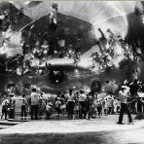
One Forgotten History of Transdisciplinarity
"At a recent meeting of PLAN I mentioned E.A.T. and drew a number of blank looks-so here is one forgotten history of transdisciplinarity and early locative projects:
Experiments in Art and Technology was founded in 1966 by engineers Billy Klüver and Fred Waldhauer and artists Robert Rauschenberg and Robert Whitman. The non-profit organization developed from the experience of 9 Evenings: Theatre and Engineering. This event, which was held in October 1966 at the 69th Regiment Armory in New York City (U.S.), brought together 40 engineers and 10 contemporary artists who worked together on performances that incorporated new technology. It became clear that achieving ongoing artist-engineer relationships would require a concerted effort to develop the necessary physical and social conditions. E.A.T. saw itself as a catalyst for stimulating the involvement of industry and technology with the arts. [blogged by Martin Rieser on Mobile Audience]
The organization worked to forge effective collaborations between artists and engineers through industrial cooperation and sponsorship. Membership was opened to all artists and engineers, and an office set up in a loft at 9 East 16th Street in New York.
Artists and the art community responded enthusiastically to E.A.T. By 1969, given early efforts to attract engineers, the group had over 2,000 artist members as well as 2,000 engineer members willing to work with artists."
Related: Whitman's Phones; PLAN Notes; and On Locative Media's European Reception.
Posted by jo at 02:04 PM | Comments (0)
UTILITY WORKS

Reflecting the Virtual Back Into the Physical
UTILITY WORKS seeks to acknowledge the importance of the mundane physical spaces where we play out our lives and provide new ways for the population to inscribe themselves into these informal public spaces. In an effort to draw new connections across our cities, UTILITY WORKS perverts existing municipal street furniture which will become points of mediation between disparate physical urban environments and the people that inhabit them. With these new urban experiences UTILITY WORKS seeks to provoke a renewed awareness of self and environment through a reexamination of familiar civic objects that we interact with every day. Just as a mirror reflects our bodies back to us, this project becomes a way of reflecting the virtual back into the physical urbanscape. Existing parking meters, post boxes, and garbage bins - the furniture of the mundane - will be activated to shape and articulate the informal public spaces of the city. Parking Meter | Post Box | Garbage Bin [via]
Posted by jo at 10:59 AM | Comments (0)
February 21, 2005
Girl Friday

A Mobile Interactive Drama Series
Glued to your mobile phone? SMS crazy? Got no time for TV but love a good drama? Girl Friday (GF) is here and it's sure to be as addictive as your phone and that soapie that you can't miss. Girl Friday's life changes when she finds a mobile phone on a tram on the way to work. She soon becomes engaged in the mysterious life of the stranger's phone. All the while she has paper clip trouble at the office; is searching for the mother she never knew, and is clawing her way to the top of the local karaoke charts.
GF beams straight to your mobile. No wires, no cords, no lengthy downloads. It's entertainment on the run - small digestible bites of life for viewers to consume at will. For the content hungry, there's a website too. Whether you can take the chunky stuff on a broadband connection or the low fat version on your 56K modem, you won't miss out on the daily sagas of Girl Friday. [via Cross-Media Storytelling]
GF will be Australia's and possibly the world's first mobile cam girl. She is a live action character who on the surface appears 'real' but in fact is a fictional part of the GF interactive world. Her story reflects the way devices (such as your mobile) are changing the way we communicate in everyday life. As GF tries to deal with the sagas of career, love and family we journey with her as a friend and confidant.
GF is a sophisticated interactive drama with a comic edge; taking its lead from outstanding programs such as Sex In The City and Ally McBeal. The program will delve into some of life's sticker questions with insight and humour, and aim to satisfy the content hungry 16-30 year old market.
Once you start, you'll be hooked and aching for your weekly GF fix.
Posted by jo at 10:52 AM | Comments (0)
Jetsam
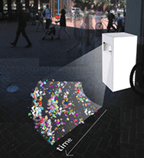
Material Worlds
While not a big fan of Intel's Jabberwocky project (the background research on familiar strangers was much more interesting to me), Jetsam - part of their Urban Probes research programme - completely fascinates me.
"Just as an archeologist excavates layers of debris from past civilizations to inform histories of ancient civilizations, so too can the discarded artifacts of today’s urban inhabitants be used to create the rich milieu of everyday stories of urban life. In fact, we can observe these patterns by extracting the secondary traces that are left behind by the flows of urban inhabitants – the archaeology of public urban trash... Our Urban Probe, Jetsam, explores urban public trash, its meaning, patterns, and usage, as it manifests itself in cities. Through this probe we hope to uncover new opportunities for technology to emerge across urban landscapes and further connect with our emotional experiences of living in cities." [blogged by Anne Galloway]
Using observations, interventions and interviews to glean information about how people interact with and interpret garbage in public spaces, they produced an augmented trash can which "exposes city dwellers to the pattern of trash interactions". The trash can records the objects thrown into it, and projects an image onto the ground of the collected artefacts. Over time, images disappear from the projection - just as artefacts disappear from the archaeological record. (Watch QuickTime movie of the can in action.)
Explorations in pervasive urban computing seem to be tending towards either gaming or narrative approaches to interacting with or understanding the city, and this project certainly falls under the story-telling category. But it's particularly refreshing to see our understanding of narrative engage a material perspective. After all, I've never heard a story that didn't involve people and things -- and surely we can do better than another city of bits.
For more on the urban probes methodology and the Jetsam project:
Urban Probes: Encountering our Emerging Urban Atmospheres (pdf) by Eric Paulos and Tom Jenkins.
And while I don't have time to get into it now, I still find it curious that Situationism is being mobilised to defend non-traditional or playful research practices -- rather than as a way of critiquing the politics and practices of technological use in everyday life. Plus, if they'd only brought in some relevant material culture studies instead of just using Lynch's image of the city...
Related:
The Garbage Project & "The Archaeology of Us" by William Rathje
Posted by jo at 07:48 AM | Comments (0)
February 20, 2005
digital cities project
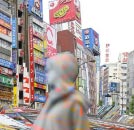
urban database as feedback loop
The Digital Cities Project is a collaboration between several Canadian research insititutions exploring digital technologies inthe urban environment. As part of the Mobile Digital Commons Network they presented at the Pervasive and Locative Arts Network [PLAN] workshop at the ICA in London on February 01-02.
The project research basis: Over the past two decades, several nations have embarked on a “digital” strategy to become key players in the new information economy. Interestingly, despite the heralded innovations these technologies promise, most nations have pursued a similar use of space and place to build isolated multimedia cities. Our research project investigates and analyzes four such multimedia initiatives beginning with the Cité Multimédia and Technoparc in Montreal. This project investigates traces of the “digital city” and its networks, from multimedia districts to virtual environments and mobile devices. The role of technology in the city has been an important focus of cultural research.
While earlier studies have concentrated on urban infrastructure such as electrification and transportation routes, new communications media have given rise to technological systems and networks that re-order the city. Through the workings of new communications media, the social and technological apparatus of cities is transformed, altering the terms of urban theory and representation.
This type of feedback loop not only expands the site of the "interface" from computer terminal to the city, but also multiplies types of input to encompass both physical and virtual data. Our research asks what would happen if the feedback loop were inverted, such that the city controlled the data, and the data's performance were always measured against the changing tides of urban life. Such a circular interplay challenges the discrete status of data, and instead requires a process of continual re-situating and adjustment within urban context. In this sense, we are reversing the logic of the feedback loop, which attempts to maintain system equilibrium in the face of disturbance. By privileging urban dynamics as the "command signal" that guides the data, the database becomes doubly urban, both documenting and being shaped by activities in the urban environment to form an expanded feedback loop.
Posted by michelle at 11:56 PM | Comments (0)
dance with avatar
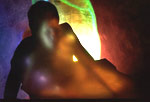
real time interactive performance event
Carol Brown Dances explores real and mediated bodily presence. Recent work The Changing Room is a real time interactive performance event intertwining the digital and the visceral in a sublime trio. In their changing room, three women leave behind the territory they know for another place, beyond what they know. A mirror becomes a screen for their mutations, a curtain a technological frontier and their table a platform for the puppetry of the virtual. Through a series of changing viewpoints the audience is lead to encounter the epic within the everyday, as a haunting virtual presence extends, mirrors and distorts the performer's behaviour. Animating the threshold between the virtual and the real, The Changing Room is an intimate exploration of our digital evolution. Designed for both live art and theatre spaces, The Changing Room encourages the shifting viewpoints of a mobile audience.
"The work which really stood out for me in Dance Umbrella for its boldness and imagination was "The Changing Room," from Carol Brown Dances, seen November 5 at Greenwich Dance Agency. Choreographer Carol Brown and architect Mette Ramsgard Thomsen transport the audience into another dimension, a world of virtual and real bodies in their challenging and creative work performed as an installation, around which the audience promenades, guided by Brown herself. Different performance areas are demarcated by one large screen and several smaller screens onto which a 'virtual body' or 'avatar' is projected. The virtual body, central to the work which is created by a technique called contour tracking, feeds off the dancers' movement. It is a mesmeric swirl of colour, circular in shape, that takes on different forms and resembles a pulsating sea anemone, a mutating cell and even a developing embryo.
"The performance by Brown and two dancers, Catherine Bennett and Delphine Gaborit, takes on the style of a lecture-demonstration in which the choreographer explains in poetic metaphorical language how they have worked as live bodies with something that is not tangible or organic. In her performance text she talks about the limitations of the organic body and how the virtual body could be something that does reach perfection, as it extends the possibilities of the physical body, "following our contours like distant geography." The most poignant and indeed emotive moments in the work are the points of connection between the dancers and the virtual body -- for example, when the dancers trace or touch the fluctuating presence on the screen or dance with it from a distance, retaining, still, a sensitivity, a constant awareness of this 'other.' Likewise, the virtual body, while visually powerful, never dominates the live action, but rather has a symbiotic relationship with it. Movements are adapted to activate the virtual presence; it can only feed off certain movements or dynamics and this poses limitations on what the body can do physically as well as offering other potential.
"A theatrical quality is established by the frequent costume changes of the three dancers, Michael Mannion's lighting and Jerome Soudan's score. Shanti Freed's costumes feature white fitted tunics which can be stretched into all kinds of shapes, thus extending the body like a second skin; baroque fashion accessories such as a white fur coat, a red satin glove and red stiletto shoes; and white underwear stripped down to reveal the muscle and flesh of these live bodies. Soudan's rich musical text, combining electronic sound and collages of classical music and monks' chanting, further wraps the work in more layers of meaning. The dancers look at times like high priestesses in a Sci-Fi film, or sometimes like Replicants but never like ordinary dancers. The lighting design, white space and screens, the text, choreography, sound, costumes and appearances of the virtual body transform the space into a cocoon-like research laboratory, an interface where different worlds meet, where each element/component co-habits or even merges. However you interpret it, "The Changing Room" is about a 'meeting,' and the three women performers are like pioneers on the verge of discovering a brave new world. The last image that we are left with is the virtual body diminishing slowly and softly, the child of these women inventors.
"The Changing Room" was the result of nearly two years of experiment and research. Thomsen, an architect working in new media and virtual environments, worked closely with Brown on how to mix realities -- that of the virtual and the live -- and developed a way of working with experimental choreographic systems which was based on Brown's interest in merging new media with dance-theater. Another enlightening aspect of "The Changing Room" is that it deals with women's bodies, and suggests birth and creation, which is refreshing in the field of new technologies, so often dominated by men sitting behind computers. "
From Flash Review
Posted by michelle at 11:35 PM | Comments (0)
February 18, 2005
Search Opera
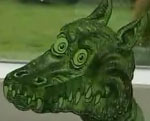
Social Collaboration as Collective Performance
MSN has launched a stealth "search opera" to help promote their new search engine. According to Sean Stewart (author behind the Alternate Reality Games The Beast and I Love Bees): "...a search opera is a story treated as a scavenger hunt and a jigsaw puzzle rolled into one. What's particularly nice about the search opera is that for a decade now people have been looking for a way to use the internet as an artistic medium. The net wants to be interactive, and it wants to be social. A search opera allows a collective audience to have an artistic experience while searching and gossiping and decoding and speculating: in short, while doing the things that the net was really born to do."
The MSN Search Opera (ARG) centers around a guy named Cy and his conspiracy website. Following the links on Cy's site and clues garnered by entering specific keywords into the MSN search engine yields videos (some of which are pretty funny), more characters, their journals, and a story that will develop over upcoming weeks.
reblogged from Alternate Reality Gaming Network
Posted by michelle at 08:31 PM | Comments (0)
ORNITORRINCO IN THE SAHARA
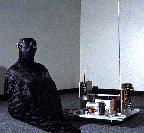
Dialogical Telepresence Event
"On October 5, 1996, Ed Bennett and (Eduardo Kac) participated in the IV Saint Petersburg Biennale with a dialogical telepresence event entitled Ornitorrinco in the Sahara. The phrase "dialogical telepresence event" refers to a dialogue between two remote participants who interacted in a third place through two bodies other than their own. Telepresence refers to the experience of having a sense of one's own presence in a remote space (and not the sense of somebody else's remote presence, as is common on the telephone). Realized in a public area of a downtown building in Chicago,..the event...consisted basically of three nodes linking the downtown site in real time to The Saint Petersburg History Museum... and the Aldo Castillo Art Gallery, located in the well known Chicago gallery district. Through these telecommunications ports of entry human remote subjects interacted with one another by projecting their wills and desires onto equally remote and fully mobile, wireless telerobotic and telecyborg objects."
Other Articles by Eduardo Kac:
TELEPRESENCE ART
DIALOGICAL TELEPRESENCE ART AND NET ECOLOGY
NEGOTIATING MEANING: THE DIALOGIC IMAGINATION IN ELECTRONIC ART
BEYOND THE SCREEN: NEW DIRECTIONS IN INTERACTIVE ART
INTERACTIVE ART ON THE INTERNET
TELEPRESENCE ART
ASPECTS OF THE AESTHETICS OF TELECOMMUNICATIONS
WRAP AROUND THE WORLD
Posted by jo at 09:09 AM | Comments (0)
February 17, 2005
THE A - Z OF INTERACTIVE ARTS
![]()
From Double Gaze to Telenoia
Double Gazing: Just as we see, hear, and feel in ways unknown directly to biological man, we also now live in an environment which increasingly hears, sees and feels us. With computer laser tracking of our retina, the artist's gaze is returned. The walls will indeed have ears, and buildings will speak volumes.
Interactivity: Trivial and non-trivial. The first is a closed system with a finite set of elements. The second is open ended and infinite in its capacity to accommodate new variables.
Telematic Imperative: When there's no more geographical boundaries, territorial aggression is as irrelevant as polarised politics. The only imperative is to connect. Nowadays even the self is permeable.
Telenoia: Computer-mediated, distributed mind-at-large: asynchronous global connectivity. In celebrating telenoia we reject the individualism of the old industrial culture- solitary, anxious, alienated, neurotically private. Telenoia replaces paranoia in the telematic culture.
From THE A - Z OF INTERACTIVE ARTS by Roy Ascott, Leonardo Electronic Almanac, Volume 3, No. 11, November 1995
Posted by jo at 08:35 AM | Comments (0)
From A to D and back again:
![]()
The Emerging Aesthetics of Interactive Art
"...Screen-based 'hypertextual works', 'instrumented physical spaces' and 'mapped virtual and real environments' are three new genres. Another 'dimension' can be added to each of these by the inclusion of fast, wide bandwidth digital communications technologies. We might call this tele-interactivity. There are identifiable sub-genres, in which the interaction is: between people geographically separated; between a person and a machine, geographically separated; or between people geographically separated at a virtual site.
The first we might call 'teleconferencing art'. Paul Sermon has produced provocative works in this vein, such as Telematic Dreaming...A second sub-genre utilises the idea of teleoperation. Eduardo Kac and Ed Bennett's Ornithorinco allows a user to teleoperate a robot (over phone lines) to explore an environment.
More provocatively, Stelarc's recent Fractal Flesh project allows his body to be teleoperated over the net. In both these works some aspect of the user (vision, volition) is extruded over the communication network to 'be' in another place. A third sub-genre (exemplified by Agnes Hegedus' Fruit Machine) allows multiple remote users to cooperate in tasks in a shared virtual environment.
The sudden explosion of networked multimedia (via the World Wide Web) has finally realised the dreams of the pioneer network artist of the mid eighties, (though this realisation has a decidedly commercial cast to it). A recent network project by the Berlin based Art+Com group, T-Vision is on the one hand chillingly panoptical, on the other it demonstrates coordinated global data retrieval in a way that the WWW only hints at. "T-Vision" offers a radical new paradigm of computation. In this work, a user rolls a beach-ball sized trackball, and a globe of the world presented on the screen, rolls correspondingly. This image is made up of a patchwork of satellite and aerial photos. This world can be zoomed. In some cases one can zoom from the entire globe down to a city street in one smooth swoop. In one case, one can zoom into the Art+Com office, and look through a video camera pointing out the window, and see real time video action! "T-Vision" can utilise the entire internet, drawing on dispersed databases for its images, so that the globe is continually updated, even to the extent of real time video, if available..."
From From A to D and back again: the emerging aesthetics of interactive art by Simon Penny, Leonardo Electronic Almanac, Volume 4, No. 4, April 1996.
Posted by jo at 08:30 AM | Comments (0)
February 16, 2005
3 minutes2
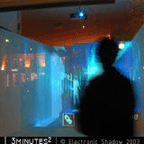
When Rooms Respond, 2
3 minutes2, by French art collective Electronic Shadow, recreates an extremely reduced living unit that can extend beyond its physical borders via the image. The space permanently reconfigures itself according to its inhabitant’s activities and also defines itself in time. The scenario presents in a few minutes the compression of most activities and functions taking place in the habitat and corresponding to its inhabitant daily life, eating, sleeping, working, etc.
The inhabitant himself is represented in the image as a silhouette and habitat is building itself around her/him as a cocoon. 3 minutes2 tries to draw the shape of a daily life modified by technologies and the presence of the virtual. Hybridization of real and virtual is fictively acquired and becomes the ground for the proposition of a habitat which anticipates the technological and social modifications making it possible.
No screens, no visible interfaces, the two characters touch the walls, make movements, the habitation responds to them. The technology has become totally invisible and the effect of technologic becomes then magic. [blogged by Regine on near near future]
Posted by jo at 09:16 AM | Comments (0)
Urban Tapestries:

Experimental Ethnography, Technological Identities and Place
"Urban Tapestries provides a mobile location-based platform to connect people with the places they inhabit through their stories, experiences and observations. Currently based on an 802.11b mesh network in the heart of London, ordinary people author their stories of the city and embed them in the places that inspire them. Others who are logged into the system can read these stories, author their own and engage the largely invisible, multidimensional layers accumulating in the city. Our research asks if people use UT in meaningful and interesting ways. Drawing from theories of everyday life and urban space, we have developed experimental ethnography as a method for investigating the relationships between communication technologies, users and the socio-geographic territories around them..." From Urban Tapestries: Experimental Ethnography, Technological Identities and Place by Roger Silverstone and Zoetanya Sujon.
Posted by jo at 08:55 AM | Comments (0)
The Living Room
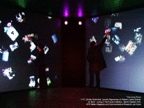
When Rooms Respond
The Living Room, by Christa Sommerer and Laurent Mignonneau, is an intelligent, interactive image, sound and voice environment. It becomes "alive" and starts to "sense" when users enter and interact with this room.
Like in a perfect surveillance system all sounds, voices, gestures and motions of the users are detected through state-of-the-art camera tracking as well as sound and voice recognition systems. When the various users start to interact and communicate with each other within this room, they will also start to communicate with The Living Room.
As if it were an intelligent organism, The Living Room will react back to the user by interpreting the collected position and speech data in form of images and image elements displayed on the room's four large projection walls. All images and image elements are directly derived from the Internet, they are The Living Room's interpretation of the users' interactions and conversations.
Since the users' position, movement and voice data are constantly changing, the images streamed from the Internet are changing constantly as well. Due to the almost unlimited amount of image data available on the Internet, the users will become completely engulfed in this virtual image space of the Internet, displayed as life-streams on the four projection walls. Besides interpreting the users' interactions and conversations visually, The Living Room also uses these data to generate and broadcast its own sound and voice output.
Conceptually The Living Room thus metaphorically plays with ideas of surveillance, detection, intelligence, interpretation, miss-interpretation and communication. To the users it provide a feeling of immersion into a constantly changing and dynamic data space, full of unpredictable images, sounds and voices.
Posted by jo at 08:10 AM | Comments (0)
February 15, 2005
LuvMsgs
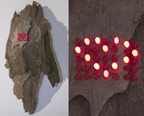
Digital Tree Carvings for a Mobile Generation
LuvMsgs, by Philip Worthington, is a reusable, digital tree carving. It's a grid of L.E.D's, implanted under the bark of special trees where people often meet. Each tree has a phone number that people can send SMS messages to. The SMS is received by the tree and displayed in the L.E.D grid for as long as the people are near. When they go, the message disappears but is remembered. Other people may come and go, leaving messages for themselves or their loved ones. When people return to the tree, it remembers the message that was stored last time they were there and displays it, as if it had always been there. [blogged by Emily on textually.org]
Posted by jo at 03:13 PM | Comments (0)
Augmented Reality:
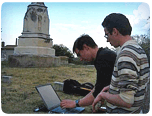
Another (Virtual) Brick in the Wall
"...There are two types of audio tours: Linear where the story that's being told has a strict order and Random Access which uses RFID to tell what object a user is near. The AR tour, though, blends the best of both, a linear story with a random access system that lets users dig deeply into whatever fascinates them, giving them access to what feels like seemingly unlimited information...
..."My idea is let's ignore the goal of perfect registration between the virtual and physical world, which seems to be the goal of many AR researchers, and instead figure out what is needed to support the creation of usable, rather than perfectly registered, systems," says MacIntyre. MacIntyre sees AR as a new artistic medium that even the non-technically inclined can work with. To further that idea, his team developed DART -- The Designers Augmented Reality Toolkit -- a set of software tools for Macromedia Director that support the design and implementation of augmented reality experiences and applications..." From Augmented Reality: Another (Virtual) Brick in the Wall by Michelle Delio, Technology Review, February 15, 2005
Posted by jo at 02:56 PM | Comments (0)
Fair Witness
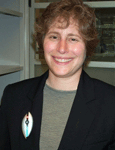
Wearable Escrow Video
Fair Witness by Rob Tow began with the question "...(W)hat is the structural inversion of television?" "Television is produced by someone else than the viewer; it comes on a set schedule; it is composed of many clips; it has high production values. The means of production are expensive, and centralized. Doing a structural inversion on these qualities lead to the idea of the short video clip, created by an individual, as a media type.
...A video camera has lots of controls, enabling fancy local recording, focusing, playback, etc. It also has local storage. What I came up with is the idea of a wearable camera, rather like a Star Trek communicator pin - which would be turned on when you slap it, and turned off when you slap it second a time...
Posted by jo at 08:01 AM | Comments (0)
February 14, 2005
Troika Ranch

Three by Troika
In Plane (1994) was a duet for a dancer and her video image representation. The dance used the MidiDancer system to allow the performer to control the generation of music, the recall of video images, the theatrical lighting and a the movements of a robotically controlled video projector.
The Electronic Disturbance (1996): Searching for the corporeal within the virtual: a "tri-coastal" dance theater performance. Inspired by the book of the same name by The Critical Art Ensemble, The Electronic Disturbance shows the human body in flux: a body whose contact with other bodies comes more and more often not physically, but electronically. The piece explores the liberating aspects of this "electronic" body, like freedom from time or gravity, as well as the more sinister implications of a body that might be easily manipulated by external forces.
Surfacing (2004) combines dance and media to explore how tiny apocalypses and the grandly commonplace create imaginary surfaces through which we may either emerge or remain held captive. Troika Ranch's Artistic Directors, choreographer Dawn Stoppiello and composer/media artist Mark Coniglio, have created a world where real-time movement is captured by onstage cameras and subsequently trapped inside the surface of the video screen. The interplay of the real and the virtual asks the question, are you on the inside or the outside, and do you have the courage to break through?
Posted by jo at 02:56 PM | Comments (0)
On Locative Media's European Reception
![]()
Lack of Diversity
Though the expertly moderated event maintained a relatively very high level of cohesion, a common criticism that arose in my discussions with other conference-goers regarded the perceived lack of diversity amongst Locative Media projects. While a few visionary art works generated some buzz...the field of Locative Media that emerged from this discourse-driven event seemed best expressed by two particular projects: Urban Tapestries and Blast Theory. While it is only a very young medium...it seems that Locative Media is developing its own stars system of artists supported by the State and, perhaps, somewhat more interestingly, by industry...
...In conclusion it is interesting to note some of Anne Galloway's words from the PLAN event. In her research, which involves Urban Tapestries as a case study, the leading academic in the area of locative media has come to question and problematise the very distinction between the new category of the artist/researcher in locative media, and that of the corporate researcher, suggesting that the latter had a much better developed sense of accountability, professionalism and ethics." From PLAN: On Locative Media's European Reception by Marc Tuters.
Posted by jo at 12:35 PM | Comments (1)
The Resonant Image

Graphic Scores for Performance
Graphic scores are images created to convey instructions for the performance of sound or music without the inclusion of standard musical notation. The Resonant Image, a new two-stage exhibition in the Stasis_Space gallery, will explore the creation and interpretation of graphic scores by contemporary artists. In Stage 01 of the exhibition, a series of new graphic scores by a variety of artists will be displayed for a four month period. During those four months, another set of artists will be asked to create sonic interpretations of these scores. Stage 02 of the exhibition will present the best of these performances as downloadable mp3s.
Posted by jo at 11:48 AM | Comments (0)
Teaching for the Wireless Commons
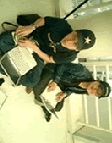
Interview with Elizabeth Goodman
[As part of WebCamTalk1.0]: Trebor Scholz: Please present your thoughts on new media education, in particular your course "Site-Specific: Wireless Networks and Urban Art Practice."
EG: This course was a mixed graduate-undergraduate seminar I taught at the San Francisco Art Institute with Alison Sant. The course examined radio signal as a medium for expression in its own right, with its own aesthetic qualities and cultural significance. It was a diverse class, with undergraduate and graduate students. The class focused specifically on sensing and representing wireless signals; we did not intend it as a technical class centered around any one tool. Using whatever medium they preferred, students were to create their own interventions into what Fiona Raby and Tony Dunne have called the "Hertzian space" of San Francisco. Final projects included a game, a proposal for a video installation, and a GPS-coordinated city tour. There have only been a few classes on wireless networks as art medium thus far, so there weren't many models to draw from.
TS: What did you learn from the experience of teaching a course with so little precedence?
EG: Learning from the experience of this course and from my own experience in school, I'd like to point to some larger issues about the state of interactive art education:
1) Art education: training for what?
2) The importance of historical perspective
3) Defining core curriculum
4) Moving the computing arts away from the computer
TS: Please describe the course more in detail.
EG: The Art Institute in San Francisco, for those of you who might not be familiar with it, is well known for its historical emphasis on conceptual art. Alison and I found that, as so often happens, our students were more comfortable with the conceptual. Partly, this is because it's easier to talk than build. But the greater issue was unfamiliarity with the underlying technologies of wireless networks "the physics of radio waves, the proliferating transceivers, the logging programs and the graphic interfaces" not to mention the pervasive fear of the unfamiliar. Even with the loan of wifi- , Bluetooth-, and GPS-enabled iPaqs from the Exploratorium, some were reluctant to experiment. And those that did were often daunted by the amount of time they had to spend troubleshooting the devices. An increasing number of people comes to courses such as ours with some knowledge of computers, but only few are comfortable with code.
Indeed, some of our students came in with far less knowledge of the tools of new media artists than we had expected. "New media" stretches from video and sound editing, to image manipulation, to animation, to interaction design, and code. The question of documenting and presenting a new media project gets complicated when you've never used a digital camera or created a web page. In addition, students were dismayed by the seemingly endless list of expensive equipment that visiting artists recommended. Laptops, GPS devices, PocketPCs, wifi-cards, specialized radio receivers. Some felt that the medium was simply unaffordable on a student budget, and the school was not planning on picking up the bills.
TS: This is a phenomenon that you also find with much of recent location-based cultural practices that require a whole set of hardware that it still unaffordable to most city dwellers.
EG: There's an interesting and common phenomenon that happens when students--anyone, really--attempts a new medium. You called it "techno-determinism" and I agree. It's a kind of blindness. The sheer difficulty of making any headway with unfamiliar and imperfect technologies such as PocketPCs running an interface to a Bluetooth GPS module, or a Flash animation, leads to the mistaken belief that the technologies themselves are the most interesting part of a project.
TS: How do you approach the confluence of art, theory and technology?
EG: Given students's understandable fears of new, unfamiliar, and un-user-friendly technologies, we need to actively reward exploration, experimentation, and sheer determination. However, the class as a whole suffers when the focus of discussion and critique moves from developing and expressing concepts to solving technical problems. Steering a course between technophobia and techno-obsession is harder than it sounds. One of the great challenges, I learned, of teaching "new media" classes that are not designed to be technical workshops is keeping promising concepts (that are often technologically interesting as well) from derailing into technological minutia. Throughout the class, Alison and I developed some strategies in response to techno-phobia, techno-obsession, and the sheer expensiveness of electronic equipment.
TS: How do you link these emerging cultural practices to their backgrounds in the history of technology, and culture at large.
EG: There is a tendency among the techno-obsessed to think that "new media" is somehow the product of a catastrophic, unbridgeable break with older tools and practices. Alison and I tried to locate the class within a longer history of site specific art and urban engagement. We started by asking students to think critically about the notion of "site" drawing on Robert Smithson's work, the notion of "non-sites" and on Gordon Matta - Clark's building deconstruction projects. We also used sources from urban theory, the Situationists and asked students to think about how we come to know a city "how we travel through it, how we map it, how we remember it. We found that bridging the old and the new produced richer conversations in new students " which is no surprise but also created a comfort zone for San Francisco Art Institute students who were already familiar with mid-twentieth century art movements.
TS: You mentioned that a few weeks into the class you asked students to switch off their computers and go to the drawing board.
EG: Yes, drawing and sketching also proved a useful introduction to the ideas and methods of the class. One of our most successful class exercises required students to create a map of the campus using only mobile phones, paper, and pencils. Working in teams, students had to both agree on how to represent mobile phone signal strength but also what areas they found most significant. The resulting critiques allowed us to talk about some core issues: the representation of temporality, definitions of site, and visualization of the invisible.
In fact, mobile phones became a cheap and accessible medium for students daunted by the expense or unfamiliarity of wifi-enabled laptops and GPS devices. For those of us who think in terms of code, it can be useful to step back and see mobile phones as a platform for development but also simple sensors in their own right. One student even used his mobile phone as a kind of game wheel, dynamically spinning paths through the city based on signal strength.
I would have loved to have my students build applications for mobile phones. But because the class blended art theory and practice, we had to think realistically about time management. We simply did not have enough time to both introduce key concepts and teach programming. As well, showing a project in a gallery is very different than supporting it on a city-wide level. Moving from the university lab to the streets means asking students to simplify their technical needs as much as possible.
TS: Could you come back to the four main issues that you introduced earlier? You started off with "Art education: training for what?"
EG: One of the subtexts running through in-class discussion was the desire to be taught specific tools, Photoshop or Flash, for example. There is a lot of fear about the high cost of education in North America, about getting jobs, and that is reflected in these demands for vocational training. I think many will agree with me when I say that undergraduate art courses should not focus on software. Defining education by the tools currently in vogue reduces learning to a set of instruction manuals. As we have all discovered, learning is often more a changing set of practices than abstract, static data.
Which brings me to my second point: defining a new media core curriculum. I think student calls for software-based training indicate a deep insecurity. Many students are not sure what they are supposed to know and how they are supposed to learn it. That is a very disconcerting situation. And part of the role of a faculty member is to answer those questions through curriculum development.
A curriculum is or should be the articulation of a community's understanding of disciplinary boundaries: what they value, what they exclude, what they require. I had a fairly traditional undergraduate art education, based around a choice of prerequisite classes: drawing, sculpture, photography, graphic design. Drawing was mandatory. As a master's student at New York University, I had another core curriculum: programming, basic electrical engineering, visual design, and communications. Everything was mandatory. Communications included training in Photoshop, video editing, etc. but it came wrapped in a larger conversation about the social significance of technologies.
I personally believe digital media core curricula should include programming and drawing. But I'm not the deciding factor in discipline-wide curriculum development. The faculty of every school has the responsibility to decide what their students should learn. I don't think we'd see wildly divergent curricula. But internal conversations need to happen so that consensus can emerge and students get consistent messages about what they need to succeed.
TS: An additional starting point was your emphasis of moving the computing arts away from the computer. Please elaborate.
EG: To me, this is perhaps the most important point: moving the computing arts away from the computer. One of our greatest struggles during the class was the fixation on the technical at the expense of the conceptual. We suggested refocusing projects, but more than once we found that students did not believe that sketching counted as part of their work as digital artists. Yet in retrospect, it's significant that the semester's most successful exercise was based on drawing.
For us, the lesson was that teaching the digital arts should not be confined to digital media. Many institutions without the budget for expensive equipment can use diagrams and formal logic as a proxy for circuitry. Nothing can totally replace learning by doing, but teaching the underlying principles of computing still helps students. As Casey Reas points out, code creates the tools we use; it's an important medium in itself. I think that teaching drawing can serve as an important bulwark against the fixation on technology, and it can remind students to focus on the underlying ideas that they strive to communicate.
So, I see several issues: I feel conflicted about the perception of the teaching of "new media" as something that is completely new. Another issue is thinking solely of what we produce as solely a function of media. I think we'll do ourselves and our students a service if we think less about newness, less about a specific media, and more about continuing art practices based around the implications of computing.
About:
Elizabeth Goodman's design, writing, and research focuses on critical thinking and creative exploration at the intersections of new digital technologies, social life and urban spaces. She has a master's degree from New York University's Interactive Telecommunications Program and has spent this fall as a visiting lecturer on site specific art and wireless networks at the San Francisco Art Institute. For a course bibliography visit www.molodiez.org/biblio_goodman.pdf. More examples of Elizabeth's work in urban gaming and cellphone interfaces can be found at www.confectious.net. [via Rhizome]
Posted by jo at 11:18 AM | Comments (0)
Peau d'Âne
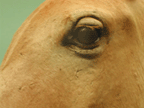
Locating Immaterial Materials
Peau d'Âne by Valérie Lamontagne: in the Charles Perrault fairy tale Peau d'Âne, a young princess, whose family's riches are dependent on a gold-excreting donkey, orders impossible wedding gifts from her father in order to avoid marrying him: three dresses made of immaterial materials. The first is to be made of the "sky" and should be as light and airy as the clouds. The second is to be made of "moonbeams" and should reflect the same lyrical intensity as the moon at night. The third, and last, is to be made of "sunlight" and should be as blinding and warm as the sun above.
Lamontagne will develop three wearables based on the Charles Perrault folk tale. Each dress--as a networked costume--aims to hybridize notions of computer interfacing and fashion. The "patterns" on the interactive material of the dress will morph according to information transmitted from a wireless weathervane to a computer chip implanted in the fabric. Utilizing wireless and solar-powered energy sources, Peau d'Âne goes beyond "making something out of nothing" and becomes a functional article marking another step in our aspiration to build truly ubiquitous objects.
InterAccess Electronic Media Arts Centre
Open Studio: February 19 - March 2, 2005
Work-in-progress Exhibition: March 4 - 24, 2005
Progress Presentations:
Saturday, February 19, 2005; 3 - 5pm
Saturday, February 26, 2005; 3 - 5pm
Valérie Lamontagne is a Montreal-based artist, freelance art critic and curator. She received her BFA (1993) and MFA (2001) from Concordia University (Montreal) where she is presently teaching in the Digital Image/Sound & Fine Arts program. Valérie has been exhibiting in and curating shows across Canada since 1997.
InterAccess is a centre for electronic media arts that enables artists and the general public to explore the intersections of art and technology. It is Ontario's only gallery and production facility devoted exclusively to electronic and new media art.
InterAccess Electronic Media Arts Centre
401 Richmond Street West, Suite 444
Toronto, Ontario, Canada
Gallery Hours: Tuesday - Saturday, noon - 5pm
Free Admission.
Related >>
Posted by jo at 10:56 AM | Comments (0)
playListNetWork
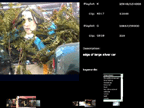
Environment for Collaborative Authoring
playListNetWork is a distributed video editing database that allows multiple users in different locations to edit and annotate media clips and playlists simultaneously. The project was initiated by artists interested in collaboratively authoring multi-threaded audio visual works. It's comprised of three parts: the playListNetWork software developed in consultation with the artists, the audio visual media content made with the software and an interface to visualize and navigate the authored structure. The application called disPlayList is the public view and interface for a streaming media work authored with the playListNetWork software. It is a web application embedded in a browser using various plugins to display media. As an interface it is used to visualize the multi-threaded playlists and provide navigation through a 3d representation of their structure. "Though playListNetWork is not performance in a real time sense - the network was used for the authoring and the display of our distributed collaboration."--Willy Le Maitre
Posted by jo at 09:38 AM | Comments (0)
spam on your mobile
It's not just inevitable; it's here already. A survey was released this week, Carlo Longino writes in TheFeature "indicating that 80 percent of mobile users have received spam to their handsets -- not that that's any surprise, but the results may be a wake-up call for mobile operators. Respondents said their most likely response to mobile spam would be to change carriers, and that receiving mobile spam hurts their perception of the carrier and its brand. For carriers that don't act decisively to stop spam -- and help marketers understand that just because it's a mobile message doesn't mean it can't be spam -- the outcome looks bleak.
Of course, as new mobile technologies emerge, what is and what isn't considered spam changes, too. Geotagging isn't a new concept, but Siemens is pitching a new iteration of it, explicitly suggesting it could be used for advertising purposes. The company says users would be able to shut off the service, but what happens when users turn off for good? The dilemma highlights the need for tools to help cut through the inevitable clutter, even before the service gets off the ground."
Posted by newradio at 09:07 AM | Comments (0)
February 12, 2005
Location-based SMS
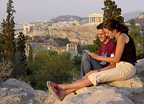
Virtual Post-Its
The German company Siemens, in collaboration with the Ars Electronica Center and the University of Linz, in Austria, is developing a new software called Digital Graffito that delivers location-based mobile messages. According to the new Siemens' press release (Feb. 02, 2005), the messages work as virtual post-its, that is, they are SMS attached to specific places. "When the recipient reaches the defined point, the message appears on his or her display. Unlike the classic SMS, the message is not sent to the addressee as such, but is only activated when the addressee comes within a defined radius of the location specified for the graffito. Another difference is that, if required, the message can be read not only by one person, but also by a number of cell phone users -- like a real graffito plastered on a building wall". One of the foreseeable applications for the software include tourism: tourists visiting a place could receive messages on their cell phones depending on where they are, and where they are looking at. It's like bringing the idea of the museum guided tour to public spaces. Although the software commercial release is only planned for 2 years from now, that's perhaps a sign of how location-based applications may be embedded in the ludic side of our lives in the near future -- besides location-based games. [Posted by Adriana de Souza e Silva]
Posted by at 05:33 PM | Comments (0)
Guest Blogger
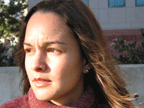
Adriana de Souza e Silva
Adriana de Souza e Silva is a Senior Researcher at the UCLA Graduate School of Education and Information Studies (GSE&IS) at CRESST (Center for the Study of Evaluation). She holds a Ph.D. on Communications and Culture at the Federal University of Rio de Janeiro, Brazil. From 2001 to 2004 Adriana was a visiting scholar at the UCLA Department of Design | Media Arts. Adriana’s research focuses on how new media interfaces, such as mobile technologies, change our relationship to space and create new social environments via media art and location-based mobile games. She holds a Masters degree in Communication and Image Technology at the Federal University of Rio de Janeiro, Brazil. [Related (1), (2), and (3)]
Posted by jo at 11:04 AM | Comments (0)
February 11, 2005
syn chron

Architectural Body as Interface: Space.Light.Sound.
Visual artist and musician Carsten Nicolai has conceived of a mobile space that serves as acoustic body, resonating space and projection surface all at once - a crystalline architectural body whose translucent skin is the vehicle for both acoustic and optical events. Electronic music composed by Nicolai generates modulations in laser-projected light. The composition, designed to run for the duration of the installation, is planned for daytime and nighttime conditions as well as potential live presentations. The architectural body is a sound and light space that visitors can enter into, or they can also perceive it from the outside, even at a distance.
This mobile architecture is a prototype that the artist has developed together with architects Finn Geipel and Giulia Andi, LIN as well as with engineer Werner Sobek. Along with the latest in laser technology, Nicolai experiments with the special acoustic conditions of the crystalline space.
Carsten Nicolai, born 1965 in Chemnitz, has developed a special approach to the connection between art and music, between visual and acoustic perception, in his works since the mid-1990s. His stance as artist and musician may be compared with that of a researcher. In constantly new experimental arrangements, Nicolai seeks to overcome separations between human sensory experiences and to transform natural scientific phenomena, such as sound and light frequencies, into events perceptible for the eyes and ears. "syn chron" represents the largest project to date in Nicolai's endeavor to create a symbiosis between architecture, light and sound.
The "syn chron" project takes place as part of the "Musical Works by Visual Artists" performance series, which Freunde Guter Musik Berlin has realized in collaboration with the Nationalgalerie Berlin since 1999 and, since 2002, with MaerzMusik festival of the Berliner Festspiele. Within this series, Carsten Nicolai's work occupies a special position. It can be thought of as an experiment in which the artist is active not only at the border zones of art and music, but also at their interface with science.
Posted by jo at 05:59 PM | Comments (0)
A Situationist Critique of Computer Games
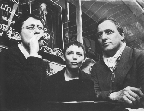
Interactivity is Preferable to Boredom
"A key premise of the mobile-technology game industry is that the pleasure of interactivity is preferable to boredom. Who would choose simply to sit on a train or wait in a line when you could be distracting your brain and hands with a game? Idleness, slowness, contemplation, being mentally present in a situated context have no place in this wired world. But for those who were alive before this hyperactive culture grew up around us, it was during those interstices of life’s activities that we breathed, relaxed, observed, thought things over. Listen up - even the smallest fragments of your idle time have now been colonized with meaningless, addictive junk. Junk that is part of the fabric of the Spectacle." From Piercing the Spectacle: A Situationist Critique of Computer Games by Brenda Laurel [via]
Posted by jo at 05:41 PM | Comments (1)
GilbertandGrape
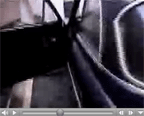
First Chapter: Lone Ranging Romance
10/02/05 13.00: Latitude 550 North, Body temperature: 36.8 c. Weather: Rain shifting to hail. First Chapter: we were about to take the Volvo Amazon for a spin and map out an interview. It seems like the ignition might need to be replaced before we do, alas another day at the garage for GilbertandGrape. So put on your favourite music and watch the sun set, knowing that we do that to. See you next month same channel same day. We are currently reading poetics of failure. Check out this networked performance on the link Live Reportage
Every Thursday in the second week of the month GilbertandGrape will be sending a live reportage of their preparations and work with Lone Ranging Romance. By interviewing heroes we meet on our drive/way we look to document a fragrance of nostalgia. Our quest is to return the lone ranger(elg) to the sun never setting. Lone ranging romance - our epic storyline for the next 4 years. Watch our live reportage online. Stay tuned and meet us for a date.
Posted by jo at 02:25 PM | Comments (0)
February 10, 2005
Dziga Vertov Performance Group
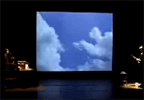
Performance Hybrids
Founded by artist/director Douglas Rosenberg in 1991, Dziga Vertov Performance Group's purpose is to create works bridging numerous disciplines including dance, performance and the visual and media arts. It takes its name from the Russian filmmaker of the early 1900's. DVPG's fundamental mission is to create new and challenging works of art based in the language of performance, dance and media that often combines voice, text, video and projected images. The work of DVPG is concerned with both content and form. The purpose of the work is to engage the audience, other artists and community groups in a dialogue that reaches beyond the usual performer/spectator relationship. In order to do this, we have set out to create a hybrid form of performance that is intended to both engage and challenge, using concepts and images that speak to contemporary and historical issues of human existence.
One of DVPG's many projects is ADaPT, an interdisciplinary association of artists, technologists and scholars from five educational institutions dedicated to research and critical dialogue on performance and media in telematic space.
ADaPT comprises five dance studios in five universities in the USA.:
1. Arizona State University
2. Ohio State University
3. University of California-Irvine
4. University of Utah
5. University of Wisconsin
In Wisconsin, the ADaPT team consists of Douglas Rosenberg (principal investigator), Chris Dowling (telematic technologist) and Jeffrey Gray Miller (technical director).
The objectives of ADaPT are to:
* create a site for telematic collaborative inquiry for the purpose of developing new models of practice and training techniques for the creation of networked dance and performance
* explore embodiment and somatic intelligence through reconceptualization of spirit, body and machine in Internet 2 culture- develop a shared mediated space for investigating performance and creative collaboration through a distributed environment across time zones
* situate research within a larger cultural and political context that acknowledges how mediated performances both frame and are framed by issues such identity, privilege, and access.
Posted by jo at 11:48 AM | Comments (0)
Seamful Game
![ubicompclient[1].gif](http://www.turbulence.org/blog/images/ubicompclient[1].gif)
Glitches are Integral
Seamful Game, by Matthew Chalmers from the University of Glasgow (Scotland), is a GPS and WiFi based game played in the streets using PDAs. To be successfull, two teams of runners must develop an understanding of the network coverage and the effect of signal strength. It thus turns the patchy network coverage, usually seen as a problem, into an important feature of the game.
Players travel around a designated area collecting digital "coins" (which appear all over the map, including in places not covered by the 802.11b wireless network) and uploading them to get points. To gain these points, players must upload the coin to the server, by pressing the "upload" button on their PDA in an area where there is 802.11b coverage. If players attempt to upload coins in an area not covered by WiFi, the upload fails and they loose all the coins they are carrying. [blogged by Regine on near near future]
Only by understanding the boundaries of the network, and the effect of signal strength on their ability to upload coins, and thus score points, will players be successful in winning the game.
The "Pick Pocket" feature of the game allows a player to steal coins from other players nearby. The player has to be inside network coverage, and use the GPS to get within 10 meters of another player (also within network coverage). By pressing the "Pick Pocket" button, they can grab any coins the victim is carrying but has not uploaded yet.
Plus, scattered around the map are "Mines". If a player moves to within 10 meters of a mine, it will detonate and the player's PDA will be temporarily disabled.
Posted by jo at 09:36 AM | Comments (0)
Performance and Live Art

Seeking a New Vocabulary and Practice
"Live Art as a practice draws freely on the widest range of references, influences and disciplines and is therefore hybrid or interdisciplinary by nature: it challenges both single art-form practice and received ways of seeing, thinking and doing. Embracing the broadest range of innovative interdisciplinary activities (deriving from theatre, dance, music, fine art, cinema and video, new technologies and popular performance arts) it characteristically finds alternatives to the assumptions of any one of these disciplines, a process that forms its over-arching research imperative. Given its multi-faceted origins its performances only rarely derive from prepared text but more frequently finds inspiration through close observation, new technologies, social intervention, music, visual image, politics and by challenging alternatives including mixed and colliding media, site specific work and time-based events as well as 'actor/role' created performance seeking to offer a new vocabulary and practice to the performing arts."
Performance & Live Art Group Members at The Nottingham Trent University: Frank Abbott, Dr Johannes Birringer, Peter Bowcott, Andrew Brown, Matt Hawthorn, Dr Adrian Heathfield, Richard House, Dr Sophia Lycouris, Nikki Milican, Thomas Mulready, Professor Barry Smith, Stelarc.
Posted by jo at 08:58 AM | Comments (0)
Corpos Informáticos
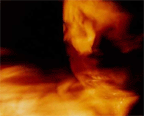
Bodies Re-Dimensioned by Technology
"The research group Corpos Informáticos was created at the University of Brasília (Brazil) by researchers, professors and students from the Visual and the Dramatic Art Courses in 1992. The central concern of this research...is the human body mediated by technologies: the existing human body is daily crossed over by imperceptible or perceptible technical elements from the most tender age; the body of the other is constructed in the same way - the image of other bodies (spectral) also makes us aware of our own – printed, broadcast, distorted, corrected images…one that becomes object of desire, desire of being, desire of becoming, and yet desire of manipulating, of possessing; our bodies and their prostheses – be them means of locomotion, reading, seeing, hearing, or creating – all of them are somehow interactive; finally, bodies constantly re-dimensioned by new technologies, and soon new bodies, new consciences." From Performance Art and Digital Bodies by Maria Beatriz de Medeiros.
See also:
Performative Sites: Intersecting Art, Technology, and the Body
Performance Art in Telepresence: Information and Communication in the World Net of Computers
Performance in Telepresence: the Body in Telepresence
Tenouous Border of the Performance Artistic Language, its Possibilities Within Technological Means
Posted by jo at 08:13 AM | Comments (0)
February 09, 2005
Cyburbia Productions

Live Movies
Cyburbia Productions, a multimedia performance studio, focuses on the collaborative creation of "live movies," syntheses of cinema, theater and music. The company’s work employs digital projection and sound technologies, and filmic narrative techniques, to construct moving stage pictures and sonic theater, in which live actors interact with animated performers, and emerge from or vanish into projected environments, settings and dreamscapes.
Projects include: SILENCE & DARKNESS is a live movie for the cell phone age by Kirby Malone, and passages from Jean Baudrillard, Guy Debord, and Heiner Müller. See list of productions here.
Posted by jo at 11:54 AM | Comments (0)
Performance in Plato’s Cave
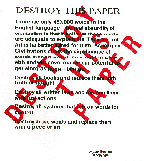
Three Distinct Performances
On Saturday, April 24th, 1999 at 9:24 and 21 seconds, a portion of the Performance in Plato's Cave was transmitted over the internet. In an attempt to follow the Plato’s Cave Performance we have to realize that there are three distinct performances going on simultaneously.
1. The Fake Performance was made to transmit from another location over the Internet in case the equipment failed at the Cleveland Performance Art Festival. The equipment did fail and the fake was transmitted; 2. The Environmental Performance was Alice in Wonderland's tea party adapted to a modern world environment. This also is the Internet Performance; The Non-Performance was a preparation for a conventional performance that would not occur.
To do an Internet Performance you have to get an audience...My goal was to get one viewer...The counter/trackers indicated that at least five people hit the site at the time of the performance.
Posted by jo at 11:43 AM | Comments (0)
PacMan Must Die
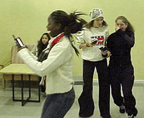
Collaborate or Lose
Students at the Future Applications Lab in Göteborg, Sweden have developed PacMan Must Die, an innovative video game with a playing field distributed across mobile wi-fi-enabled devices belonging to all the players. The game combines dynamics of play in physical places with the world of video games in a new way. To win, players have to cooperate with one another physically. [originally blogged by Sean on Cheesebikini?; reblogged by Sean on Smartmobs.]
Posted by jo at 11:18 AM | Comments (0)
Excellent video dance in Tokyo:

Asami Tachibana and Yoji Toyosaki
Asami Tachibana's "Women who never gather in group" was excellent video dance in Japan. Asami Tachibana studied dance at Annex Sengawa Factory with Miyako Kato in Tokyo. Kato was a talented choreographer of modern and post modern dance. Thus, Tachibana is also influenced by Japanese modern dance and contemporary dance. She also studied dance in Belgium.
In the video dance, they mixed red Japanese female dancer's body and their expressive motion. Video image directed dancers' movement softly. In particular, Mariko Konno, who is one of the star dancers in Japanese Dance World, performed sharply and elegantly Ayaka Azechi, a daughter of Miyako Kato, also danced in this piece. Azechi performs at Tokyo in her own concept, "body installation" these years.
A video artist, Yoji Toyosaki, has worked with dancers and musicians for years. Some parts of images, for example, scales of objects, remind Japanese traditional art to the audience. Just as an effect of sliding projector, the images changed one by one in the stage. [posted by Yukihiko YOSHIDA]
Posted by jo at 09:30 AM | Comments (0)
February 08, 2005
Eyes of Laura
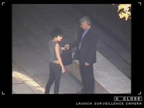
I Love Surveillance
I received this note a few days back:
Hello, I am Laura, a security guard at the Vancouver Art Gallery. Through work, I have access to a lot of security cameras. I hacked a way to put one of these online on my Website so you can see it and control it. I love surveillance and keep a web journal or blog of what I see and put up video and images of things that happen.

The obvious reference had me Googling for an online synopsis of The Eyes of Laura Mars. (Nice one, Laura!) [originally posted by Joy on newsgrist]
Posted by jo at 06:30 PM | Comments (0)
Space Rules: Techno-Nomad Theatre

Affective Connections
"This nomadicism of the journey within the field of the curtain aims neither at an exoticising of the non-Western, nor at a sense of the nomadic as a non-location, a globalised, dispersed, non-participatory spatiality. Instead, in my phenomenological witnessing, the nomadic theatre emerges as a nonsense space of traversed images and stories. It makes strange landfalls, and connects different points in different archives of knowledge. Within the amalgamation of histories, gears, levers, curtains and flesh, the body does feel - does engage in affective connections, creating machines of meaning-making." From Space Rules: Techno-Nomad Theatre by Petra Kuppers, published in Body, Space & Technology Journal, Number 7.
Posted by jo at 03:28 PM | Comments (0)
Internet Performances as Site-Specific Art

Telematics and Performativity
"The following analysis is driven by the thesis that Internet Performances should be approached through site-specific art and its theory. To approach Internet Performances as a site-specific art is a – both theoretically and historically – promising premise. First, this positions Internet Performances in the 20th century tradition of experiments between both the performing and fine arts on the one hand and media technology on the other hand. Second, the concept of site-specific art emphasises the transformed modes of perception in telematic Internet Performances. These transformed modes of perception are influenced by the Internet’s mediality." From Internet Performances as Site-Specific Art by Julia Glesner published in Body, Space & Technology Journal Volume 3, Number 1.
Posted by jo at 03:04 PM | Comments (0)
February 07, 2005
SuperCollider
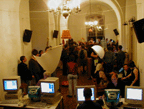
First Class Closures
SuperCollider is an environment and programming language for real time audio synthesis. You can write programs to generate or process sound in real time or non real time. SuperCollider can be controlled by MIDI, the mouse, Wacom graphics tablet, and over a network via Open Sound Control.
SuperCollider is mostly like Smalltalk but has a different syntax. Everything is a first class object including integers, floats, chars. It uses Smalltalk style dynamic binding of methods. SuperCollider has very flexible argument passing: positional arguments, any-order keyword arguments, variable length argument lists, default argument values. SuperCollider has first class closures like Scheme and co-routines.
Posted by jo at 12:49 PM | Comments (0)
RADIO TAXI

Going Glocal
RADIO TAXI is a Taxi Gallery narrowcast and webcast initiative. Taxi Gallery is literally a black cab situated in a council estate on the outskirts of Cambridge, England. Since Sept 2001, over 25 different artists have made new works in response to the specific context offered by the gallery and its location. Taxi Gallery is a project that reaches for an extended conversation with local, national and international audiences (via its website) in response to a broad range of challenging contemporary artworks, approaches and ideas.
The translocal or "glocal" philosophy of Taxi Gallery is reflected in the forthcoming RADIO TAXI project which will integrate a 3 mile radius analogue FM broadcast with a worldwide digital transmission via a server capable of handling multiple streams. RADIO TAXI will be a live(ly) mix of locally originated programmes and interventions (significant community involvement by neighbourhood residents of all ages will be developed, including several major projects with Coleridge Secondary School and an evolving radio club), a curated programme of invited sound works and a schedule of sonic art from all over the world.
Kirsten Lavers, cris cheek, (TNWK) and Simon Keep invite sound artists (including writers, poets, visual artists, musicians working with sound) to submit work for a short range FM and internet radio event in late May and early June 2005.
Submission Deadline: 1 May 2005-01-22 latest
Transmission Dates: 6pm 27 May – 6am 31 May (GMT) & 6pm 3 June – Midnight 5 June (selected highlights)
Queries to: info @ radiotaxi.org.uk
Posted by jo at 09:54 AM | Comments (0)
THE INTERNATIONAL DATABASE OF CORPORATE COMMANDS
![]()
An Imperative Call
The Institute for Infinitely Small Things announced its new research initiative today, THE INTERNATIONAL DATABASE OF CORPORATE COMMANDS (IDCC). This research database is open to submissions of corporate commands from researchers around the world. A Corporate Command is an instruction work, a call to action in the form of an imperative: "Just Do It"; "Turn on the Future"; "Live without Limits"; "Tap into great taste"; "Think different"; "Ride the light"; "Live Like You Mean It."
It is the hypothesis of the Institute for Infinitely Small Things that these commands, largely and consciously ignored by a public over-saturated with advertisements, function at the scale of the infinitely small. Tiny events that do not disturb ones consciousness or disrupt ones identity as "free" agents, these commands seep under the surface of the individual and lay claim to the territory of the Deleuzian Virtual. Desire, memory, and future potentiality become territories for conquest and tactics for social and political control.
By compiling, tabulating, concretizing and enacting these commands in the International Database of Corporate Commands (IDCC), the Institute for Infinitely Small Things seeks to better understand the mechanisms behind this deployment of power and its larger cultural ramifications.
EVENTS & EXPEDITIONS: The Institute for Infinitely Small Things will be using the IDCC to lead a series of public expeditions during the 2005 Boston Cyberarts Festival in April-May. The Institute's temporary laboratory will be situated at Space 200 at 200 State Street in Fanueil Hall. Please check the website for exact times and locations of expeditions.
PARTNERSHIPS: The Institute welcomes requests for Research Partnerships from institutions and individuals engaging with similar questions. The IDCC is licensed under a Creative Commons Attribution-NonCommercial-ShareAlike 2.0 license. We are interested in publishing, syndicating or linking to any research that is relevant to our mission.
ABOUT THE INSTITUTE FOR INFINITELY SMALL THINGS
The Institute for Infinitely Small Things is a research organization dedicated to the creation, collection and documentation of all of the infinitely small things in the world, past, present and future. The Institute's research projects are concerned with creating a critical cartography through which to explore notions of political power, social controls, collective agency and human freedom.
Contact: The Institute for Infinitely Small Things
info @ infinitelysmallthings.net
617-501-2441
Posted by jo at 09:46 AM | Comments (0)
February 04, 2005
Ghosts

Preserving Fragments of Thought
Ghosts is a digital sculpture that plays with the notion of 'instant' communication, such as email, web chat and text messages. The projected sculpture is created from the messages visitors contribute through text on a keyboard or mobile phone messages. These words, ideas and fragments of thought are preserved and given a longer-term existence, shaping a continuously evolving digital sculpture for others' future experience out of the messages you leave behind. Ghosts prompts visitors to question and interact. Where do all our text messages go? Are throwaway ideas worth keeping? Visit Ghosts and let your message form the art-work and make a mark on another's experience.
The installation was recently exhibited at the Montreal Festival of New Cinema and has been created by Squidsoup, a group of interactive designers, artists and musicians whose aim is to expand current thought within interactive art and design. Squidsoup's work has won awards and accolades within the new media industry, including a BAFTA nomination and entry into the British Design & Art Direction (D&AD) Awards Year Book.
Posted by jo at 04:24 PM | Comments (0)
Distributed Improvisation

Distributed Improv~Programmed by n0media
Live improvisation connecting sonic artists, musicians and visual artists sited at University of East Anglia (Norwich, UK), International Centre for Music Studies (Newcastle, UK), Kingston (Canada) & Dublin Institute of Technology (Dublin, Ireland) in a series of realtime audio/ visual networked performances. The event can be accessed live online between 8pm & 9.30pm GMT. Performers include; Phil Archer, John Ayers, Andre Bosman, John Bowers, Laura Cannell, Nick Melia, Matt Rogalsky, Alex Sanders, Will Scrimshaw, Tom Simmons, Shigeto Wada and Liam Wells.
The event features four improvisations, each utilising specially created local or remote networks, sharing realtime audio/visual & performance data between performers in spatially remote locations. For more information go to >>
Posted by jo at 09:43 AM | Comments (0)
Breathe On Me
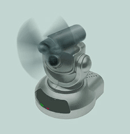
Breath as a Fundamental Form of Communication
Breathe On Me is an installation/internet work consisting of a three-walled space with a number of hybrid fan/webcam devices affixed to the walls. The fan/webcam devices are modified netcams such that Internet users can control the direction of a fan from the remote webcam view combined with pan and tilt controls. Internet users can choose one of the devices in the space, log onto the "FanCam," visually locate visitors in the physical space and then turn on the fan and "breathe" towards the person. Visitors in the physical space are invited to enter a space where they will be remotely seen and will not know who is telepresent. Once seen by internet participants, they will receive an offer of fan "breath" as a fundamental form of communication. Visitors who enter the space are asking to receive a telepresent stranger’s glance and touch in the form of wind. Internet users reach out to physical visitors in the simple offer of moving air.
To visit in telepresence: Links will to the live performance will be available at the live site within 24hrs. Opening Telepresently and in Situ: Friday, February 4, 2005; 8.00-9.30 PM, Pacific Standard Time, Continuing live through February 6; INTERACTIVE FUTURES 05: Technology in the Life World, Victoria, BC @ Open Space Artist-Run Centre
Posted by jo at 09:35 AM | Comments (1)
E N T E R C H A N G E

The Power of Performing and Nature
"...Contemporary views about performance and performativity emphasise ephemerality, contingency, improvisation, adaptation - whether in the ‘doing’ of an everyday action or in the creation of an aesthetic event. It is a relational process through-and-through.
Those qualities can be seen to inhere in the processes of nature, the continual change of environments and in the actions of the beings and entities which are more-than-human. Rather than ‘nature’ as a background to human performance, or merely a subject for representation, the processes of human performance can be seen as continuous with those of nature – sometimes resonant together, sometimes not..." Read full essay >>
Posted by jo at 09:20 AM | Comments (0)
Aware Project
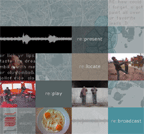
Mediating Fluid Memory
The aware project proposes an experimental location-based medium for mediating fluid memory, ‘story-making’, and aims to facilitate the (playful or critical) re-imagination of the lived city of Helsinki. It explores the positive potential of widespread use of networked, mobile media devices to raise awareness of communal relationships with place, and the real-time organisation/ disorganisation of spatio-temporal meaning.
The project concept is to enable participants to contribute images, sounds and text via their mobile device to a collective online database, to be rebroadcast to the public environment of their origin, either anonymously or tagged with a user-name. However the contributions may be moved around to other cell locations in the city, re-interpreting their meaning and potential relationship to other forms and place. This site has a wonderful Related Links page.
Posted by jo at 08:01 AM | Comments (0)
February 03, 2005
Mudlarking
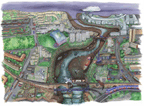
Imaginative Connections
Mudlarking is a reimagining of the traditional guided tour which empowers young people to engage creatively with their built environment. It involves users as co-designers, producing a tour by making use of mobile technologies to both initiate and respond to a scattering of located nodes in and around Deptford Creek. Key Stage 3 students will walk usually inaccessible and fenced off areas of Deptford, making imaginative connections between large and small scale relics that connect histories and stories embedded in the creek itself. Read Mapping Boundaries: Reading Everyday Urban Texts and Users as Architects: Thinking Big/Reading Small by Juliet Sprake.
Mudlarking in Deptford explores how associative histories, stories and visions of Deptford Creek can be woven into a guided tour of the area – one in which the participant actually produces the tour. The site itself provides a rich, immersive stimulus for pervasive technologies to seamlessly engage young learners in creatively responding to a real and live local environment. In giving students opportunities to exploit the well-known form of the guided tour, they can actively explore relations between process and outcome in a project where process is the outcome.
Posted by jo at 06:33 PM | Comments (0)
free103point9

Transmission Arts
free103point9 is a 501(c)(3) nonprofit media arts organization focused on establishing and cultivating the genre Transmission Arts by promoting artists who explore ideas around transmission as a medium for creative expression. These investigations include practices in AM and FM radio, Citizen's Band, walkie-talkie, generative sound, and other broad and microcasting technologies utilizing the transmission spectrum. free103point9 serves diverse public audiences through programs including an online radio station, a distribution label, a performance/exhibition/ transmission series, a preservation program, an education initiative, and a forthcoming artist-in-residency program.
Founded in 1997 as a microcasting artist collective, free103point9's goals during the formative years were focused on the microradio movement fight for the public's access to its own airwaves. free103's mobile operations made airtime available to community voices, local bands, and most significantly to a group of under-served artists shaping conceptual works specifically for radio transmission.
Posted by jo at 05:58 PM | Comments (0)
Echo Ricochet
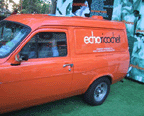
The Ebb and Flow of Perth
Cre8ive Challenge is an Awesome Arts initiative designed to engage young people in an open-ended, process-based exploration of identity. In 2003 their project included the collection of significant sound samples for a collaborative project with Scanner. The latter became a soundscape accompaniment for a journey through Perth’s urban environment.
As part of the Festival in central Perth Echoricochet was presented from an orange transit van. The public borrowed headphones and CD players and embarked on a sound-walk through the city, guided by instructions. Perth ebbed and flowed with its usual rhythms as the soundscape evolved around the listener, offering a relaxed yet heightened awareness of the urban environment’s passing details. [Read an interview with Scanner on neural.it]
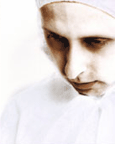
Found Mobile Phone Conversations
Scanner: This British audio auteur, composer and sonic spy trawls the hidden noise of the modern metropolis to create absorbing, multi-layered soundscapes. Scanner's already vast body of work spans from early controversial compositions using found mobile phone conversations to a more recent focus on trawling the hidden noise of the modern metropolis as a symbol of the place where hidden meanings and missed contacts emerge.
Scanner's diverse practices include audio CDs, soundtrack composition for films, performances, radio, and site-specific intermedia installations. He has performed and created works internationally including SFMOMA USA, Hayward Gallery London, Pompidou Centre Paris, Tate Modern London, Corcoran Gallery DC and the Royal Opera House London. He has collaborated with artists from numerous genres including musicians Bryan Ferry and Laurie Anderson, The Royal Ballet and Random Dance companies, composers Michael Nyman and Luc Ferrari, and artists Mike Kelley and Derek Jarman.
Scanner continually seeks unconventionaly environments for his works: in 1999 he performed Surface Noise on a London Bus around the city, in 2000 he performed over 20 KM of beach in Italy on the public speaker system, re-soundtracked Jean Luc Godard's seminal film Alphaville, and wrote the soundtrack to a working morgue in Paris in 2002.
Among his recently completed works are Into The Blue, a gallery installation using 10,000 latex balloons, soundtracks for The Royal Ballet's Qualia and Random Dance Company's Nemesis, a string quartet entitled Play Along, three feature film soundtracks, and CD releases of 52 Spaces commissioned for film director Antonioni's 90th birthday, and Warhol's Surfaces, commissioned for German Radio.
Scanner's work can be heard on permanent display in the Science Museum London (Sound Curtains) and the Raymond PoincarÈ hospital in Garches France as part of the bereavement suite (Channel of Flight). His BBC radio production of Jean Cocteau's 'The Human Voice' won the prestigious Prix Marulic Award and most recently he won First Prize Neptun Water Prize for his installation Wishing Well in Germany. In 1998 he became 'Professor Scanner' at John Moore's University in Liverpool.
Posted by jo at 05:56 PM | Comments (0)
February 02, 2005
Database of Virtual Art

A Research-Oriented Overview
The Database of Virtual Art documents the rapidly evolving field of digital installation art. This complex, research-oriented overview of immersive, interactive, telematic and genetic art has been developed in cooperation with established media artists, researchers and institutions. The web-based, cost-free instrument - appropriate to the needs of process art - allows individuals to post material themselves. Compiling video documentation, technical data, interfaces, displays, and literature offers a unique answer to the needs of the field. All works can be linked with exhibiting institutions, events and bibliographical references. Over time the richly interlinked data will also serve as a predesessor for the crucial systematic preservation of this art.
Posted by jo at 12:43 PM | Comments (0)
On Haptics
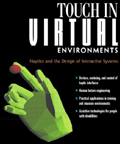
Extending Our Sense of Touch
"...That's how I learned that in ecological psychology, "haptic touch" is the name of the system that lets us feel stuff through objects we hold, to "feel the road through the stick or cane, or even through the wheels of a car we are driving." (Andy Clark) explained that, in this instance, "force and torque sensors buried in the arm" and other muscles are "activated the same way when we use a stick as when we touch with our hand." This is what allows humans (and a goodly number of our primate cousins—not to mention possibly raccoons and otters) to treat tools as if they were extensions of our bodies, extending our sense of touch through them." From Touching Your Own Future: Haptic Tools by Laurie Rowell. Also see Touch in Virtual Environments: Haptics and the Design of Interactive Systems
Posted by jo at 12:13 PM | Comments (0)
PLAN notes
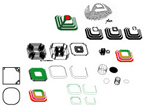
A Veritable Who's Who Gathered in London
The Pervasive and Locative Arts Network [PLAN] is currently meeting in London. Here are the real time notes being compiled by Nicolas Nova, Drew Hemment and Steve Benford. [Thanks to pasta and vinegar]
PLAN is a two day event bringing together leading international figures to review the emerging fields of locative and pervasive media. Wireless and locative technologies are enabling people to break away from traditional computer interfaces. Mobile devices are mediating new kinds of social interaction and responding to physical location and context. [related]
See Tom Carden's Day 2 and Day 1 notes, and Molly's notes too.
Posted by jo at 11:29 AM | Comments (0)
February 01, 2005
Geodetic Landlines

Dynamic Multi-User GPS Drawing Tool for Participatory Exhibitions
Geodetic Landlines--by Jen Southern, Jen Hamilton and Jon Wetherall--is an on-line multi-user collaborative drawing tool for GPS enabled mobile phones, in which users draw by moving in real space. For use in exhibitions in which the audience participates and contributes to the evolving installation, and for collaborative spatial practices between distant locations. It is both a creative and an exhibition tool for multi-user art in which the artist collaborates with a wider social group, addressing some of the problematics of working with process based social practice.
The phone application connects with a separate Bluetooth GPS device and draws a line representing this data to the phone screen, during a journey. This information is then dynamically relayed to a server via WAP. Information can also be requested from the server by a phone using the system. If the user accesses live information from a different city or country they can make collaborative drawings or navigate via the routes and decisions made by a distant audience, allowing them to see their city a new, and be connected to the spatial experience of another place and another individual.
These collaborative gps drawings will be viewed live on a website, or projected into a gallery space, where user choice or live xml feeds of weather, current events or pollution data can be used to modify line colour, thickness and opacity.
Posted by jo at 11:59 AM | Comments (0)
